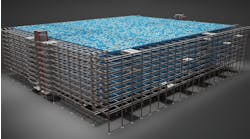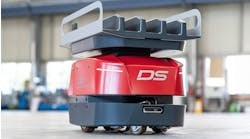Not that long ago, the big barrier to technological innovation on the manufacturing floor was part of what many of us called “the system.” The RAM. Or the CPU. Or the storage. Remember? Consultants and corporate leaders clamoured for more memory. We needed more speed. We needed more data and disk space.
Not so today. We have incredible speeds, oceans of memory, and far more data than we know what to do with. A near-infinite availability of interconnected technologies, devices, hardware and software. The machines aren’t really the problem.
The obstacle now is the people. Or rather, their lack of the right training, education and preparation for the major paradigm shifts in technology, big data, networks and automation that we are seeing.
Kaboom – there go the silos
Education is by definition predictive. Led by academics and industry, we prepare people today for what they will be doing tomorrow when they leave school and join the workforce.
This worked pretty well if you were an engineering student, say, in the 1970s. You came out well-prepared to grind away at problems in a silo, alongside others doing the same, as generations of your ilk had done before you. Together but separate, you contributed to power plants, paint, prostheses, bridges, highways, sewage systems, control systems, dishwashers, drugs, food, and a whole lot more.
The internet chipped away at technical human silos in manufacturing, to some extent by destroying the old lines of communication. Rather than having communication travel up and down hierarchically, through approved, proper management channels, it became everyone-and-everywhere enabled. We could all talk to each other, and to a much greater extent, we did.
The paradigm shift is that silo work no longer delivers enough value, because cooperative work can accomplish so much more.
As an example, think of installing a door handle in an old-style automotive plant. On that iconic 20th century material shop floor that everyone came to know through textbooks, magazines and movies, each task is broken-down, repetitive, and unchanging.
But today’s information shop floor is fluid and dynamic in nature, not discrete. No such task breakdown can easily exist. The nature of the task is ever-changing and must be aligned with the material shop floor, which also evolves.
The key is cooperation
What’s the key to success in this digital twin plant, this ever-changing organism that meshes the physical/material and virtual/information worlds? Human cooperation.
To compete in hyper-competitive markets and the realities of paper-thin-margins, manufacturing departments are now pushed to build fluid lines of communication with sales, customer service, finance and other aspects of the business. The old ways were cumbersome, rigid, and moved too slowly, awaiting too many approvals.
The new way is an ever-reinforcing and dynamic cycle. Today’s latest dreams and designs require a connected, non-silo work style to be brought into being.
In an article published in the Harvard Business Review, Ron Ashkenas provides an illustration of how dysfunction and weak performance creeps into the manufacturing process. He illustrates the typical scenario of how today’s program manager routinely coordinates shop-floor matters like workflow, scheduling, conflicting priorities and other major issues with leaders from various departments. With numerous layers of command and silos, it’s a daunting challenge to bring these units together when needed. As a result, key decisions are delayed or not executed at all.
But we’re training people for jobs that don’t exist
Back to the idea of education being predictive: Today’s technical workforce is faced with jobs that weren’t imagined when the syllabus was created. I’m not talking about the new technology itself—the devices and platforms—because people can get up to speed on new technology quite quickly, particularly those who are tech-minded by nature. New technology is exciting.
I’m talking about the way the industrial (OT – operations technology) and technical (IT – information technology) worlds now operate—and the new skills that are needed to succeed. The new web of interrelationships between people, information & technology, inside and outside an organization is galaxies apart from the old hierarchical lines of connection that ran neatly through those engineering silos.
To put it another way, in the old days an engineer needed to understand what was asked—and deliver. Today, that same engineer is connected to a fluid network of many people with complex and varying demands. A much higher order of social and linguistic capabilities are required for success.
Islands of spaghetti
The size, nature and complexity of projects we now take on lead to very big failures if people are not up to speed on cooperating and communicating. And the new possibilities of IIoT provide interesting examples of this.
One Fortune 500 company I know of jumped into IIoT with two dozen programmers to analyze what could be done with the new technology. Working in silos (as they were accustomed to), with no defined structure, standards, or requirements for UX (user experience) and limited internal collaboration, they demonstrated everything they could do—and that you should not do.
The programmers, pumped up by the new technology, showed no interest in asking the holy grail question: “What problem could I solve that has value?” They were barely aware of the manufacturing process and failed to ask questions that would address that issue. Showing no interest in the people who would actually use the software, they created a user experience (UX) that they would never have stooped to using themselves, on their own devices.
The two dozen programmers did not even work together; they set off in two dozen different directions. The end results were unmaintainable, rejected by the users, and offering no business value. Management was back to square zero; IIoT was now a bad word. And the programmers were upset because of the waste of all this “great stuff” they had delivered.
Before their IIoT project, the organization had islands of information. Now they have islands of unmaintainable spaghetti. And of course, users hate it.
It’s not about using the tools. It’s about figuring out how to work together to use the tools. Because truly working together is now a possibility, one with tremendous potential.
It’s about the connectivity
Some of the people who have chosen careers in manufacturing IT (and other areas that will use the IoT) are fond of analysis and detail—writing 3,000 lines of code, say, to achieve a certain technical feat. Yes, these skills are needed, just as mechanical aptitude is much in demand in manufacturing. But many engineers and technical problem-solvers either need more training in soft skills or a “translator” who can ask the right questions of others and apply the analysis to real-life situations.
Leaders worth their weight in gold
When I was an engineering student, the CPU, the RAM and the LED display were “the system” and I was alone in my work. Today, the internet is “the system” and teams must work collaboratively to be competitive in today’s transparent, fiercely competitive world.
As a CEO, that’s what I wish technical education was doing today – preparing individuals to see and leverage the true power of connectivity. Rather than training them for a past long gone.
Leaders who get the power of a connected team working towards a connected goal? They’re worth their weight in gold.










